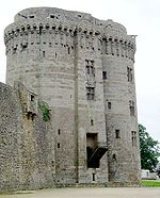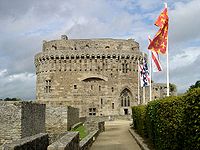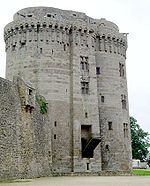
Château de Dinan
Encyclopedia
The Château de Dinan consists of a keep
, in the town of Dinan
, in the Côtes-d'Armor
département of the Brittany region
Brittany region
of France.
 The keep and the gate are part of the 2600 metres (8,530.2 ft) of medieval rampart
The keep and the gate are part of the 2600 metres (8,530.2 ft) of medieval rampart
s which still surround the old town.
It is called Donjon de la duchesse Anne (Keep of the Duchess Anne
), and stands 111 feet (34m) high near the Saint Louis
gate. John V, Duke of Brittany
built the keep in 1382-1383. The keep is formed by a union of two tall circular towers; a moat
and drawbridge
divides the keep from the outside of the ramparts as well as from the inside of the city. Extensive machicolation
s overhang the wall head providing defensive coverage of the base of the tower.
The castle was listed for protection as a monument historique
in 1886. It is owned by the commune
and houses the local museum.
Keep
A keep is a type of fortified tower built within castles during the Middle Ages by European nobility. Scholars have debated the scope of the word keep, but usually consider it to refer to large towers in castles that were fortified residences, used as a refuge of last resort should the rest of the...
, in the town of Dinan
Dinan
Dinan is a walled Breton town and a commune in the Côtes-d'Armor department in northwestern France.-Geography:Its geographical setting is exceptional. Instead of nestling on the valley floor like Morlaix, most urban development has been on the hillside, overlooking the river Rance...
, in the Côtes-d'Armor
Côtes-d'Armor
Côtes-d'Armor is a department in the north of Brittany, in northwestern France.-History:Côtes-du-Nord was one of the original 83 departments created during the French Revolution on 4 March 1790. It was created from part of the former province of Brittany. Its name was changed in 1990 to...
département of the

Régions of France
France is divided into 27 administrative regions , 22 of which are in Metropolitan France, and five of which are overseas. Corsica is a territorial collectivity , but is considered a region in mainstream usage, and is even shown as such on the INSEE website...
of France.

Defensive wall
A defensive wall is a fortification used to protect a city or settlement from potential aggressors. In ancient to modern times, they were used to enclose settlements...
s which still surround the old town.
It is called Donjon de la duchesse Anne (Keep of the Duchess Anne
Anne of Brittany
Anne, Duchess of Brittany , also known as Anna of Brittany , was a Breton ruler, who was to become queen to two successive French kings. She was born in Nantes, Brittany, and was the daughter of Francis II, Duke of Brittany and Margaret of Foix. Her maternal grandparents were Queen Eleanor of...
), and stands 111 feet (34m) high near the Saint Louis
Louis IX of France
Louis IX , commonly Saint Louis, was King of France from 1226 until his death. He was also styled Louis II, Count of Artois from 1226 to 1237. Born at Poissy, near Paris, he was an eighth-generation descendant of Hugh Capet, and thus a member of the House of Capet, and the son of Louis VIII and...
gate. John V, Duke of Brittany
John V, Duke of Brittany
John V the Conqueror KG was Duke of Brittany and Count of Montfort, from 1345 until his death.-Numbering:...
built the keep in 1382-1383. The keep is formed by a union of two tall circular towers; a moat
Moat
A moat is a deep, broad ditch, either dry or filled with water, that surrounds a castle, other building or town, historically to provide it with a preliminary line of defence. In some places moats evolved into more extensive water defences, including natural or artificial lakes, dams and sluices...
and drawbridge
Drawbridge
A drawbridge is a type of movable bridge typically associated with the entrance of a castle surrounded by a moat. The term is often used to describe all different types of movable bridges, like bascule bridges and lift bridges.-Castle drawbridges:...
divides the keep from the outside of the ramparts as well as from the inside of the city. Extensive machicolation
Machicolation
A machicolation is a floor opening between the supporting corbels of a battlement, through which stones, or other objects, could be dropped on attackers at the base of a defensive wall. The design was developed in the Middle Ages when the Norman crusaders returned. A machicolated battlement...
s overhang the wall head providing defensive coverage of the base of the tower.
The castle was listed for protection as a monument historique
Monument historique
A monument historique is a National Heritage Site of France. It also refers to a state procedure in France by which national heritage protection is extended to a building or a specific part of a building, a collection of buildings, or gardens, bridges, and other structures, because of their...
in 1886. It is owned by the commune
Communes of France
The commune is the lowest level of administrative division in the French Republic. French communes are roughly equivalent to incorporated municipalities or villages in the United States or Gemeinden in Germany...
and houses the local museum.

